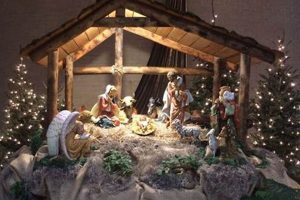The concept involves creating intentionally garish or humorous holiday-themed garments through self-directed crafting. This often includes repurposing existing sweaters and adorning them with an excessive application of embellishments like felt cutouts, pom-poms, glitter, and battery-operated lights. A notable example is attaching miniature reindeer figures to a sweater, seemingly in mid-flight, and surrounding them with copious amounts of artificial snow.
This activity offers a creative outlet, fostering individuality and resourcefulness. It serves as a popular theme for social gatherings and contests during the holiday season, promoting lighthearted fun and friendly competition. The trend’s origins can be traced back to the late 20th century, gaining significant momentum in the early 2000s as a counter-cultural fashion statement and evolving into a mainstream celebratory practice.
The subsequent discussion will delve into diverse approaches for executing such projects, highlighting readily available materials, techniques for embellishment application, and considerations for achieving optimal comedic effect while maintaining structural integrity of the base garment.
Crafting Effective Holiday-Themed Garments
The following guidelines aim to facilitate the creation of visually striking and structurally sound holiday-themed sweaters. These recommendations emphasize planning, material selection, and execution techniques for optimal results.
Tip 1: Pre-Planning and Design Conceptualization: Before commencing, sketch a detailed design. This visual blueprint should incorporate specific embellishments and their intended placement on the sweater. This minimizes errors and ensures a cohesive final product.
Tip 2: Material Selection and Durability: Prioritize durable and lightweight materials. Heavy embellishments can weigh down the sweater, causing discomfort and potential damage. Consider the washability of chosen materials for garment longevity.
Tip 3: Adhesion Techniques: Employ a combination of fabric glue and stitching for secure embellishment attachment. Glue provides immediate adhesion, while stitching offers long-term reinforcement, preventing detachment during wear.
Tip 4: Strategic Placement of Embellishments: Arrange elements to maximize visual impact while maintaining wearer mobility. Avoid placing large or protruding objects in areas prone to friction or compression.
Tip 5: Incorporating Light Sources: When using battery-operated lights, ensure the battery pack is securely fastened and easily accessible for replacement. Conceal wiring to prevent tangling or snagging.
Tip 6: Theme Consistency: Maintain a clear and consistent theme throughout the design. Avoid incorporating disparate elements that clash visually or conceptually, diluting the overall impact.
Tip 7: Size and Proportionality: Select embellishments that are appropriately sized in relation to the sweater. Overly large or disproportionate elements can appear clumsy and detract from the overall aesthetic.
These recommendations highlight the importance of meticulous planning and careful execution. Adhering to these guidelines can elevate the final product from a simple craft project to a visually impactful and structurally sound holiday garment.
The subsequent section will address common challenges encountered during the creation process and offer practical solutions for overcoming them, providing readers with a comprehensive guide to successful garment construction.
1. Creativity
The execution of deliberately unconventional holiday-themed garments is fundamentally dependent upon creative expression. Creativity dictates the selection and arrangement of embellishments, transforming a plain sweater into a visually arresting, and often humorous, artifact. The absence of creative input results in a generic or uninspired product, failing to capture the essence of the project. A tangible example includes the difference between a sweater simply adorned with randomly glued-on ornaments and one meticulously designed to depict a narrative scene involving Santa Claus and his reindeer, the latter demonstrating a higher degree of creative investment.
The application of ingenuity extends beyond mere decoration; it encompasses the repurposing of materials and the novel employment of crafting techniques. Examples might include using recycled Christmas cards to create layered embellishments or employing unconventional materials like bottle caps or discarded toys to form humorous motifs. Furthermore, creativity influences the narrative or thematic direction of the garment. A sweater might parody popular holiday tropes, reference contemporary culture, or even deliver a subtle social commentary, leveraging the medium for artistic expression. The degree of creative freedom directly impacts the originality and memorability of the completed article.
In summary, creativity serves as the driving force behind successful holiday-themed garment projects. It influences every stage, from initial conceptualization to final execution, determining the visual impact, thematic resonance, and overall distinctiveness of the piece. Overcoming creative blocks often involves brainstorming sessions, visual research, and a willingness to experiment with unconventional ideas, thereby ensuring a final product that is both memorable and reflective of individual artistic vision.
2. Originality
Originality is a critical determinant of success within the realm of self-directed crafting of holiday-themed apparel. It differentiates a project from commercially available alternatives and mass-produced items, elevating the final product from a simple craft to a distinctive expression of individual creativity. Without originality, the garment risks blending into a sea of similar designs, diminishing its impact and memorability.
- Conceptual Uniqueness
Conceptual uniqueness pertains to the underlying idea or theme that informs the design. A truly original garment moves beyond generic holiday imagery, such as Santa Claus or reindeer, to incorporate unexpected elements, narratives, or parodies. For example, a design might depict a humorous take on a historical event with a holiday twist, or incorporate an inside joke relevant to the wearer or their social circle. The implication is that the garment becomes more than just a decorative item; it becomes a conversation starter and a reflection of the wearer’s unique personality.
- Material Innovation
Material innovation involves the creative and unconventional use of crafting supplies. Instead of relying solely on felt, glitter, and pom-poms, an original design might incorporate repurposed materials like bottle caps, discarded electronic components, or even edible decorations (though their longevity would be limited). The selection of materials contributes significantly to the garment’s visual texture and tactile appeal, offering opportunities for both aesthetic enhancement and commentary on consumer culture.
- Technique Application
Technique application refers to the inventive utilization of crafting techniques to achieve a specific visual or structural effect. Beyond simple gluing or sewing, a truly original design might employ embroidery, appliqu, or even unconventional methods like heat-transfer printing or 3D printing to create intricate details. This approach not only enhances the garment’s aesthetic complexity but also demonstrates a commitment to craftsmanship and attention to detail.
- Humorous Delivery
Humorous delivery is an essential component of originality within this context. A truly effective design goes beyond mere silliness to incorporate wit, irony, or satire. This might involve subverting traditional holiday imagery, creating unexpected juxtapositions, or referencing contemporary memes or popular culture. The key is to elicit a genuine laugh or smile from the observer, thereby establishing a connection and enhancing the garment’s memorability.
These facets of originality are not mutually exclusive; in fact, they often overlap and reinforce each other. A garment that excels in all four areas is likely to be a truly exceptional and memorable example of self-directed crafting of holiday-themed apparel. Furthermore, originality can also increase the social value of the item, making it a desirable piece for contests or themed parties. The more unique and memorable the design, the more likely it is to stand out and garner attention.
3. Humor
Humor functions as a central tenet within the realm of intentionally unattractive holiday-themed garments. The primary objective in creating these garments is frequently the elicitation of amusement. The effectiveness of a design is directly proportional to its capacity to generate laughter or smiles from observers. The intentional incorporation of comical or absurd elements constitutes a defining characteristic, distinguishing this practice from traditional holiday attire.
The integration of humor can be achieved through diverse mechanisms. Exaggerated ornamentation, such as oversized pom-poms or an excessive application of glitter, serves as a simple yet effective means. Ironic juxtaposition, where unexpected elements are combined (for example, a picture of a shark wearing a Santa hat), provides a more nuanced approach. Parody, specifically the satirical imitation of traditional holiday imagery or cultural trends, represents another avenue. A practical illustration includes a sweater depicting reindeer engaged in activities incongruent with their typical depiction, such as playing video games or attending a yoga class. The successful execution of humor relies on a careful balance between absurdity and relatability. Elements must be outlandish enough to be funny but also grounded in recognizable contexts to resonate with the viewer.
The application of humor enhances the social value of the garment. Such garments are commonly worn at gatherings and competitions centered on the theme of intentionally unattractive holiday attire, occasions where the capacity to amuse others directly contributes to the wearer’s success. A failure to integrate humor results in a garment that lacks the defining characteristic of the genre, diminishing its appeal and social impact. Consequently, humor is not merely an aesthetic choice but a fundamental component dictating the purpose and reception of these self-directed crafting endeavors.
4. Materials
The selection of appropriate materials is fundamental to the successful execution of holiday-themed garment projects. The choice directly influences the garment’s aesthetic appeal, durability, and wearer comfort. Inappropriate material selection can compromise the final product, resulting in structural instability, visual discordance, or an uncomfortable wearing experience. For instance, utilizing overly heavy embellishments on a lightweight sweater can cause sagging and distortion, while abrasive materials can irritate the skin.
Material choices extend beyond mere aesthetics, impacting the longevity and washability of the garment. Employing washable fabrics and colorfast embellishments ensures the garment can withstand repeated cleaning cycles without fading or damage. Conversely, non-washable materials limit the garment’s usability and lifespan. The decision to use recycled or repurposed materials also reflects a commitment to sustainability, adding an ethical dimension to the creative process. An example of this could be utilizing felt scraps from previous projects or repurposing old holiday decorations as embellishments. The effect of appropriate material choice is a sweater that is both visually appealing and practical.
Ultimately, the selection of appropriate materials is a critical factor in achieving a successful holiday-themed garment. It demands a careful consideration of aesthetic, practical, and ethical implications. Failure to adequately address material selection can undermine the entire project, while informed choices can significantly enhance the final product. The challenges faced often relate to balancing cost-effectiveness with desired aesthetic and durability, with innovative solutions frequently involving the resourceful utilization of readily available or recycled materials.
5. Technique
The application of specific techniques directly determines the aesthetic quality and structural integrity of self-made, deliberately unattractive holiday-themed garments. The effectiveness of a technique significantly influences the visual outcome and durability of the embellishments. Incorrect application, such as using inappropriate adhesives or neglecting proper stitching methods, can result in detached elements, compromising the overall design. For instance, poorly applied fabric glue may fail to secure heavier ornaments, leading to their dislodgment during wear or cleaning.
Different techniques cater to varying materials and design complexities. Embroidery provides a method for intricate detailing, while appliqu offers a means of layering fabric shapes for dimension. The strategic use of sewing, as opposed to solely relying on adhesives, reinforces the attachment of embellishments, extending the garment’s lifespan. Consider the practical application: securely affixing battery packs for light-up elements necessitates careful consideration of weight distribution and accessibility for battery replacement. A well-executed technique not only enhances visual appeal but also ensures the garment can withstand repeated use.
In summary, mastering appropriate techniques is paramount for successful garment construction. Technical proficiency ensures durability, aesthetic consistency, and wearer comfort. The challenge lies in selecting and executing techniques that complement the chosen materials and design while balancing creative vision with practical considerations. A strong understanding of technique translates directly into a higher-quality final product, enhancing both its visual impact and long-term wearability, an essential component for this particular crafting activity.
6. Durability
Durability constitutes a critical, often overlooked, aspect of creating holiday-themed apparel. The intention of these garments may be comedic, but their construction should not preclude a reasonable lifespan. Garments intended for repeated wear during seasonal events necessitate structural integrity capable of withstanding use and cleaning.
- Material Selection and Longevity
The choice of materials directly impacts the lifespan of the finished product. Substandard adhesives, flimsy fabrics, and non-colorfast embellishments degrade rapidly, diminishing the garment’s utility. For example, felt cutouts affixed with craft glue may detach after a single washing, necessitating repairs or rendering the garment unusable. The employment of durable, washable fabrics and robust adhesives is therefore essential for extending the items lifespan.
- Construction Techniques and Reinforcement
The method of assembling embellishments significantly affects the garments resilience. Simple gluing, while expedient, offers limited long-term security. Incorporating stitching, either by hand or machine, reinforces the attachment points, preventing detachment under stress. Strategic reinforcement of high-stress areas, such as around heavier ornaments or battery packs, is paramount. A real-world example involves securing battery-operated lights with both glue and stitching to prevent wires from detaching and rendering the lighting system inoperable.
- Washability and Maintenance Considerations
The capacity to clean the garment without causing damage is a key element of durability. Embellishments that are not colorfast may bleed or fade during washing, altering the garment’s appearance. Utilizing washable fabrics and testing the colorfastness of embellishments prior to application mitigates this risk. Furthermore, adhering to appropriate washing instructions, such as hand-washing or using a delicate cycle, prolongs the garments lifespan. A case in point is a sweater adorned with glitter; improper washing can cause the glitter to dislodge and spread, detracting from the garment’s aesthetic appeal.
- Wear and Tear Mitigation
The garment’s design should consider the potential for wear and tear during normal use. Avoiding embellishments in areas prone to friction or snagging reduces the likelihood of damage. Strategic placement of ornaments and careful consideration of their size and shape contribute to the garment’s overall durability. As an example, large, protruding embellishments on the sleeves are more susceptible to damage than smaller, securely attached elements on the torso.
These facets collectively underscore the importance of durability in creating holiday-themed apparel. While the primary intention may be to generate humor, the investment of time and resources warrants a focus on constructing garments that can withstand repeated use and cleaning, thereby maximizing their value and enjoyment across multiple holiday seasons. A commitment to durability ensures that these garments serve as lasting expressions of creativity and festivity.
7. Comfort
While the primary objective of creating intentionally unattractive holiday-themed garments often centers on visual humor, wearer comfort remains a significant, albeit sometimes secondary, consideration. The extent to which a garment can be comfortably worn directly impacts its utility and the wearer’s willingness to engage with the design. Discomfort, arising from factors such as abrasive embellishments, excessive weight, or restricted movement, diminishes the overall experience, potentially negating the intended comedic effect. The relationship between comfort and aesthetic intention is therefore a complex balancing act. For instance, a sweater densely covered in rigid plastic ornaments might achieve a high degree of visual absurdity but prove unwearable for extended periods, thereby failing to fulfill its purpose as a garment.
Achieving a reasonable level of comfort necessitates careful planning and material selection. The choice of base sweater material is crucial; a soft, breathable fabric mitigates potential skin irritation caused by applied embellishments. Consideration must be given to the weight distribution of decorations. Uneven distribution can lead to strain and discomfort, particularly over prolonged wear. Furthermore, the method of attachment influences comfort. Securing embellishments with smooth, flat seams minimizes friction against the skin. Avoiding embellishments in areas of high mobility, such as under the arms, prevents chafing and restriction of movement. As a practical example, securing battery packs for electronic elements within a padded pouch, rather than directly against the skin, enhances wearer comfort. This proactive approach ensures that the design, while visually striking, does not compromise the wearers physical well-being.
In conclusion, comfort is an indispensable component of successful holiday-themed garment creation. While visual impact and humor remain central objectives, neglecting comfort can render a garment unwearable, undermining its intended purpose. Achieving a balance between aesthetic ambition and wearer comfort requires thoughtful material selection, strategic embellishment placement, and careful construction techniques. The challenge lies in maximizing visual absurdity without sacrificing the wearer’s physical well-being, ensuring that the garment is not only humorous but also wearable and enjoyable. This understanding transforms the process from simple decoration to a nuanced exercise in creative garment design.
Frequently Asked Questions
The subsequent section addresses common inquiries pertaining to the design, construction, and maintenance of self-made, intentionally unattractive holiday-themed garments. These frequently asked questions provide insights into best practices and potential challenges.
Question 1: What constitutes an “ugly” Christmas sweater?
The term refers to a garment intentionally designed to be garish, humorous, or unconventional in its holiday-themed aesthetic. This typically involves an over-abundance of embellishments, clashing colors, and/or the incorporation of ironic or unexpected elements.
Question 2: Are there specific materials that are unsuitable for embellishing holiday-themed garments?
Materials that are excessively heavy, prone to shedding, or incompatible with washing machines are generally unsuitable. Abrasive or irritating materials should also be avoided to ensure wearer comfort.
Question 3: How can the durability of embellishments be maximized?
Employing a combination of fabric glue and stitching provides optimal adhesion. Reinforcing high-stress areas, such as around heavier ornaments, further enhances durability.
Question 4: Is it possible to incorporate electronic components, such as lights, safely?
Yes, but caution is advised. Battery packs should be securely fastened and insulated to prevent electrical hazards. Wiring should be concealed and positioned to avoid tangling or snagging.
Question 5: How can the garment be cleaned without damaging the embellishments?
Hand-washing or using a delicate cycle in a washing machine is recommended. Harsh detergents and high heat should be avoided. Spot cleaning may be necessary for delicate embellishments.
Question 6: What are some strategies for overcoming creative blocks during the design process?
Brainstorming, visual research, and experimentation with unconventional materials can stimulate creative thinking. Considering a specific theme or narrative can also provide a focused direction.
In summary, careful planning, informed material selection, and adherence to sound construction techniques contribute to the creation of visually striking and structurally sound holiday-themed garments. Addressing potential challenges proactively enhances both the aesthetic appeal and the longevity of the final product.
The subsequent section will offer a detailed guide to specific design ideas and implementation strategies, providing practical inspiration for crafting unique and memorable holiday garments.
Conclusion
This exploration of “diy ugly christmas sweater ideas” has examined various facets, from conceptualization and material selection to technique implementation and durability concerns. Effective execution demands a balance between creative expression and practical considerations, ensuring both visual impact and garment longevity. Key principles include strategic planning, careful material sourcing, and sound construction techniques to maximize aesthetic appeal and functionality.
The presented information empowers individuals to engage in this creative endeavor with a heightened understanding of the underlying principles. The creation of deliberately unconventional holiday attire offers an opportunity for self-expression and participation in seasonal festivities. Continued exploration and refinement of these techniques will likely yield further innovation and diversification within this increasingly popular crafting domain.







